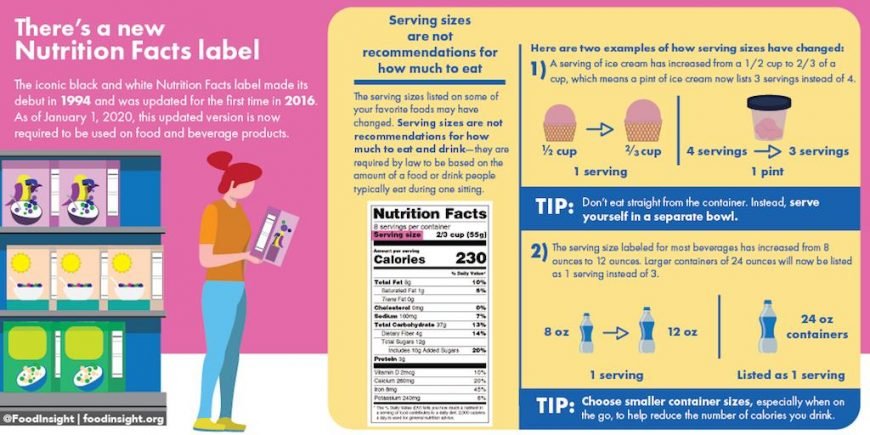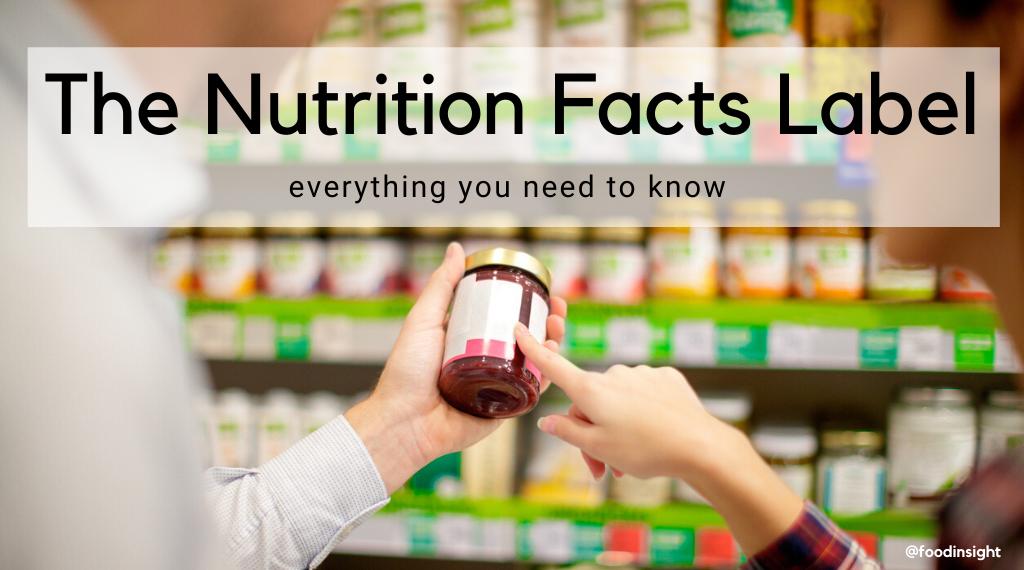Key Highlights
- Nutrition information was not always required on packaged foods and beverages prior to 1990.
- The U.S. Nutrition Facts label first appeared in 1994 and was revised in 2016. A newer, more updated version is required on products as of January 1, 2020.
- There is a new line on the Nutrition Facts label for added sugars—the first new line on the label since trans fat was added in 2006.
- Serving sizes were established in 1993 and updated in 2016.
- Serving sizes listed on packaged foods and beverages are determined by how much of that item people typically consume at one time. They are not recommendations for how much people should consume.
A history of the Nutrition Facts label
Although we take its existence for granted today, the Nutrition Facts label was not always required to be on food packages. In November 1990, the Nutrition Labeling and Education Act (NLEA) was signed into law, marking the culmination of a groundbreaking effort to provide information on food labels to help consumers make better choices and encourage food companies to produce healthier food. Prior to the NLEA, mandatory information on packaged foods was limited, with nutrition information required only on foods making a nutrition claim or those fortified with vitamins, minerals or protein. The NLEA required food packages to contain a detailed, standardized Nutrition Facts label with information such as: serving size; the number of calories; grams of fat, saturated fat, total carbohydrate, fiber, sugars and protein; milligrams of cholesterol and sodium; and certain vitamins and minerals. In May 1994, the Nutrition Facts label made its much-awaited debut—and the iconic black and white label was born.
What’s different about the Nutrition Facts label now?
Updates to the Nutrition Facts label have been long overdue. Not only have we changed the way we eat, but the scientific evidence about the health effects of what we eat has evolved as well. The recent label updates were largely driven by these two factors.
On January 1, 2020, Americans woke up to a new year, a new decade and a new Nutrition Facts label. This was the day that the largest food manufacturers (those with over $10 million in annual food sales) were required to use the revised label after the U.S. Food and Drug Administration (FDA) announced an extension to its May 27, 2016, final rule.
With the new Nutrition Facts label becoming more commonly used on your favorite products, here’s a rundown of the changes you might be seeing while shopping:
Serving sizes
There has long been confusion about how serving sizes are determined and whether or not they are recommendations for how much to eat. Serving sizes displayed on food labels are required by law to be based on the amount of a food or beverage that people typically consume during one eating or drinking occasion. These amounts, known as the Reference Amounts Customarily Consumed (RACC), have been updated for the first time since their establishment in 1993. Because the amounts for some items that people eat and drink has significantly changed since that time, serving sizes for those packaged foods have been updated to reflect more current consumption habits. The bottom line with serving sizes: They are not recommendations—they are based on the reality of how much people commonly eat or drink at one time. Think of them as information, not advice.
Tip: To help build a diet that provides the right amount of calories for you to maintain a healthy weight, try selecting smaller portions of your favorite foods.
Here are a few examples of how updated serving sizes impact new food labels:
Ice cream: The RACC for ice cream has increased from a half cup to two-thirds (2/3) of a cup. This means that a pint of ice cream now lists three servings instead of four. Because its contents are now divided by three instead of four, you will notice more calories, fat and sugar listed per serving on the Nutrition Facts label of your favorite pint of ice cream. These changes are a result of the new labeling guidelines—not product reformulation.
Tip: Try not to eat straight from the container. It’s easier to eat a smaller portion by scooping out a little at time into a separate bowl. Before going back for more, ask yourself how hungry you really are.
Beverages: The RACC for most beverages (e.g., coffee, soda, tea and water) has increased to 12 ounces, with the exceptions of juices and milk, which are still eight (8) ounces. However, larger containers of up to 24 ounces will be listed as one serving.
Tip: Opting for smaller container sizes, especially when on the go, can help you limit the number of calories you consume from beverages.
Yogurt: The RACC for yogurt has decreased from eight (8) ounces to six (6) ounces. The decrease in typical consumption is likely due to the prevalence of single-serve yogurt packaging, which typically comes in 5.3- or 6-ounce sizes.
Calories are bigger and bolder
According to recent data from the Centers for Disease Control and Prevention (CDC), more than two in five U.S. adults have obesity. And rates are on the rise—between 2000 and 2018, the prevalence of obesity increased from 30.5% to 42.4% of U.S. adults. To address this trend, the calorie information on the Nutrition Facts label is now emphasized by larger and bolded text.
No more “Calories from Fat”
While continuing to require “Total Fat,” “Saturated Fat,” and “Trans Fat,” the updated Nutrition Facts label won’t have a “Calories from Fat” category. This move was made because displaying the number of calories from fat doesn’t indicate what kind of fat the calories come from. The best available scientific evidence shows that more emphasis should be placed on the type of fat we eat (e.g., polyunsaturated over saturated) rather than the total amount of fat we eat.
Added sugars
The most talked-about addition to the new label is a line for added sugars content, which is presented in absolute amounts (grams) and as a percent Daily Value (DV). It’s the first new line added to the Nutrition Facts label since trans fat debuted in 2006. Added sugars information appears on a new line as “Includes [x]g Added Sugars” and is indented directly below “Total Sugars.” The indention indicates that the amount of added sugars is included in the amount of “Total Sugars,” not in addition to “Total Sugars.” Placing added sugars information on food labels is thought to help bring U.S. consumption of added sugars closer to recommendations (less than 10% of total calories). The most recent intake data shows that U.S. adults consume about 13% of their calories from added sugars.
Vitamins and minerals
There are four vitamins and minerals that are required to be listed on every updated Nutrition Facts label: vitamin D, calcium, iron and potassium. While calcium and iron were also required before the latest update, vitamin D and potassium are new to the list, replacing vitamins A and C. The swap was made because Americans get enough vitamin A and C in their diet but fall short on vitamin D and potassium. Both of these nutrients are vital for good health: Vitamin D helps the body absorb calcium to maintain strong bones, and potassium helps lower blood pressure, particularly for those with high blood pressure.
While vitamin A and C are no longer required, they can still be voluntarily included on the label by a food manufacturer, along with other vitamins and minerals.
Percent Daily Value Updates
On food labels, the percent DV tells you how much of your daily need for a nutrient is contained in one serving. Percent DV can be confusing, but there’s an easy way to help you quickly identify whether or not a food contributes a significant amount of the nutrients we should look to eat more of (e.g., fiber, potassium, calcium, iron and vitamin D) and those we should limit (e.g., sodium, added sugars and saturated fat). It’s called the “5/20 rule.” A food is considered low in something if its DV per serving is 5% or less. Conversely, a food is considered high in something is its DV per serving is 20% or more.
Package and Portion Sizes
The sizes of food and beverage packages and portion sizes served to us can influence how much we consume. The package size is not always the same as the serving size, and the serving size is not always the same as the portion we choose to or should eat. For package sizes that list between one and two servings (based on the RACC), the calorie and nutrient information is required to reflect the total amount in the package but be labeled as one serving. This is because people can reasonably consume the entire food or beverage in one sitting, even though it is technically more than the RACC. Soda bottles of 16.9 and 20 ounce are prime examples of this phenomenon. People commonly drink the entire soda bottle even though the RACC for soda is now 12 ounces (updated from 8 ounces). Therefore, 16.9- and 20-ounce bottles are listed as containing one serving, and the nutrition information displayed is determined by the number of ounces in each bottle. Try choosing smaller package and portion sizes as often as possible to help you limit the number of calories you consume from high-calorie foods and beverages.
For packages that contain between two and three servings, manufacturers are required to provide a “dual column” label. Dual column labels convey two important pieces of information—the total amount of calories and nutrients per serving (the first column) and per package (the second column). This makes it easier for people to know what’s in the entire package.
The Bottom Line
With its new bolder visual elements and updated information, the new Nutrition Facts label makes it easier to use and understand food labels. Be an informed shopper and use food labels to your advantage by comparing products to choose the foods and beverages that will help you build a healthier diet.
For more resources on how to understand and use the new Nutrition Facts label, visit the FDA website.

This article contains contributions from Alyssa Pike, RD; Kris Sollid, RD; and Ali Webster, PhD, RD
